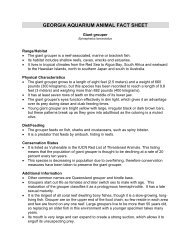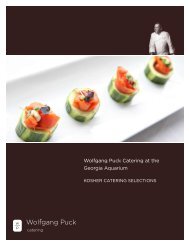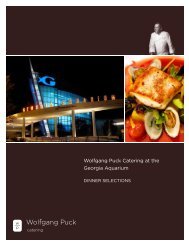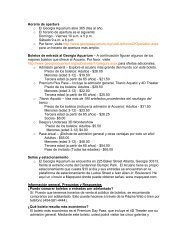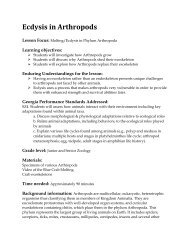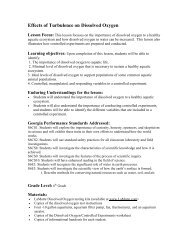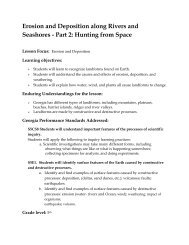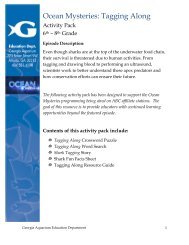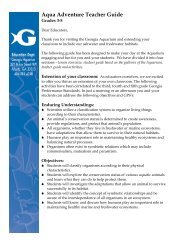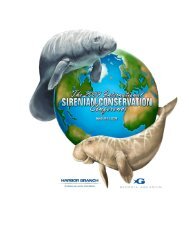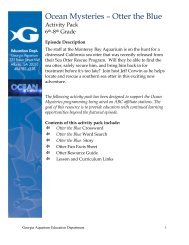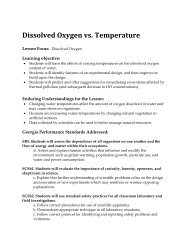Georgia Journey - Georgia Aquarium
Georgia Journey - Georgia Aquarium
Georgia Journey - Georgia Aquarium
Create successful ePaper yourself
Turn your PDF publications into a flip-book with our unique Google optimized e-Paper software.
<strong>Georgia</strong> <strong>Journey</strong><br />
Teachers Guide<br />
Grades 3 rd -5 th<br />
Program Description: Pack your bags, we are heading out to explore <strong>Georgia</strong> and its<br />
many habitats. Students will examine the amazing adaptations these animals have to<br />
survive in unique habitats of <strong>Georgia</strong>.<br />
Enduring Understandings for Coastal Critters:<br />
- <strong>Georgia</strong> has many habitats including mountains, marshes, swamps, forests, and<br />
the ocean.<br />
- Animals have a variety of different adaptations that help them survive.<br />
- Animals are classified into groups by different characteristics they possess.<br />
Objectives:<br />
Students will:<br />
- Explore the different animals that live in <strong>Georgia</strong> and around the world; learning<br />
about the habitats they occupy.<br />
- Discuss different adaptations the animals have to live in their habitats.<br />
- Classify animals that live in <strong>Georgia</strong> into groups.<br />
<strong>Georgia</strong> Performance Standards Addressed:<br />
Third Grade<br />
S3CS4. Students will use ideas of system, model, change, and scale in exploring<br />
scientific and technological matters.<br />
a. Observe and describe how parts influence one another in things with many parts.<br />
S3L1. Students will investigate the habitats of different organisms and the<br />
dependence of organisms on their habitat.<br />
a. Differentiate between habitats of <strong>Georgia</strong> (mountains, marsh/swamp, coast,<br />
Piedmont, Atlantic Ocean) and the organisms that live there.<br />
c. Identify features of animals that allow them to live and thrive in different regions<br />
of <strong>Georgia</strong>.<br />
d. Explain what will happen to an organism if the habitat is changed.<br />
S3L2. Students will recognize the effects of pollution and humans on the<br />
environment.<br />
a. Explain the effects of pollution (such as littering) to the habitats of plants and<br />
animals.<br />
b. Identify ways to protect the environment.<br />
• Conservation of resources<br />
• Recycling of materials<br />
<strong>Georgia</strong> <strong>Aquarium</strong> Education Department 1
Fourth Grade<br />
S4CS4. Students will use ideas of system, model, change, and scale in exploring scientific and<br />
technological matters.<br />
a. Observe and describe how parts influence one another in things with many parts.<br />
S4L2. Students will identify factors that affect the survival or extinction of organisms such as<br />
adaptation, variation of behaviors (hibernation), and external features (camouflage and protection).<br />
a. Identify external features of organisms that allow them to survive or reproduce better than<br />
organisms that do not have these features (for example: camouflage, use of hibernation, protection,<br />
etc.).<br />
Fifth Grade<br />
S5CS4. Students will use ideas of system, model, change, and scale in exploring scientific and<br />
technological matters.<br />
a. Observe and describe how parts influence one another in things with many parts.<br />
S5L1. Students will classify organisms into groups and relate how they determined the groups with<br />
how and why scientists use classification.<br />
a. Demonstrate how animals are sorted into groups (vertebrate and invertebrate) and how vertebrates<br />
are sorted into groups (fish, amphibian, reptile, bird, and mammal).<br />
Pre-visit activities:<br />
1. Water Address – Students will identify aquatic animals and their habitats by analyzing clues<br />
that describe the animals’ adaptations.<br />
Post-visit activities:<br />
1. Creature Cover Up – Students will review adaptations learned by answering questions to<br />
reveal an animal underneath.<br />
<strong>Georgia</strong> <strong>Aquarium</strong> Education Department 2
Instructor table Instructor table<br />
Room Setup / Needs:<br />
<br />
<br />
<br />
<br />
<br />
Indoor, climate-controlled space without carpeting where 4 tables are set up as stations with<br />
chairs for the students to rotate around<br />
Chairs should be divided evenly between the 4 tables, with a chair for each student plus extra<br />
as needed to keep the same number of chairs at each table (ex: for a full group of 50 students,<br />
we will need 4 tables with 13 chairs at each table)<br />
2 tables set up at the front of the room to hold animals, biofacts, and equipment<br />
Access to the room at least 30 minutes prior to the program<br />
Access to electrical outlets and a space to dump used water<br />
<strong>Georgia</strong> <strong>Aquarium</strong> Education Department 3
Water Address<br />
Adapted from the Project WET k-12 Curriculum & Activity Guide.<br />
Grade: 3 rd – 5 th<br />
Objective: Students will identify aquatic animals and their habitats by analyzing clues that<br />
describe the animals’ adaptations.<br />
Duration: 50 minutes<br />
Vocabulary: adaptation, camouflage, coral reef, fish, mammal, freshwater, saltwater, predator,<br />
prey<br />
Materials:<br />
<br />
<br />
<br />
<br />
<br />
10 sets of “Adaptation Cards” for each group of students<br />
pencils and paper for scorekeeping<br />
10 sets of animal picture cards (optional)<br />
10 sets of habitat cards (optional)<br />
globe or world map (optional)<br />
Background:<br />
Three-quarters of Earth’s surface is covered with water. There are many different types of aquatic<br />
habitats such as open ocean, coral reef, lakes, rivers, marshes, and swamps. To survive in these<br />
different environments animals have special features, or adaptations. These adaptations have<br />
developed over time and serve several important purposes. They can help an organism get food,<br />
protect themselves from enemies, and survive in many different conditions.<br />
There are many ways in which animals have adapted to surviving in aquatic habitats. Fish have<br />
streamlined bodies and fins to help them move through the water quickly. Their coloration helps<br />
them to hide from predators or helps predators sneak up on their prey. Some fish have added<br />
protections such as spines and spots on the back half of their bodies to confuse their predators. Fish<br />
also have gills so that they are able to filter the oxygen out of the water to breathe. Some aquatic<br />
birds have webbed feet for swimming as well as glands that produce waxy oil for waterproofing their<br />
feathers.<br />
Aquatic animals also have adaptations to allow them to survive in severe temperatures. For example,<br />
animals like belugas and sea lions have blubber (a thick layer of fat beneath their skin) to protect<br />
them from cold water. Sea otters do not have blubber, but they have very thick fur that serves the<br />
same function.<br />
Procedure:<br />
1. Discuss how Earth’s surface is covered with about 71% of water and demonstrate this using a<br />
globe or map. Aquatic habitats are home to thousands of species of animals. Tell the students<br />
<strong>Georgia</strong> <strong>Aquarium</strong> Education Department 4
that today they are going to learn about different aquatic habitats, some of the animals that<br />
live there, and the adaptations that allow them to survive in their habitat.<br />
2. Make a list on the board with the students of all the aquatic habitats they can think of. Make<br />
sure to include both freshwater and saltwater habitats. (Discuss the difference between these<br />
two terms if necessary.)<br />
3. Tell the students that each one of these habitats includes animals that have adapted to the<br />
specific conditions of that habitat to be able to survive there. Have the students define<br />
adaptation. Give an example such as fish adapting to live in water by having gills.<br />
4. Tell the students they are going to play a riddle game in which they must guess an organism’s<br />
identity and “water address” (or habitat) based on the clues on the adaptation card. Have<br />
students form groups of three or four.<br />
5. Hand out a set of the “Adaptation Cards”, “Animal Cards”, and “Habitat Cards” to each<br />
group (last two sets are optional depending on your group). Instruct students to spread out<br />
the animal and habitat cards on their desks or floor.<br />
6. Explain that each card lists four adaptations of a certain animal. Based on the clues, students<br />
will match the animal and the habitat to the adaptations on the card (animal and habitat cards<br />
are an extra help for students).<br />
7. Each student in the group should take turns being the “reader”. The reader starts the game by<br />
picking an “Adaptation Card” and reading the clues one at a time until another student in the<br />
group correctly identifies the animal and the habitat (using the pictures for help). Answers are<br />
listed at the bottom of each card.<br />
8. The student who correctly guesses both the name of the organism and its water address<br />
(habitat) receives points for the group (a scorekeeper should keep track of the group’s points).<br />
Keep track of the score as follows:<br />
a. One clue read = four points<br />
b. Two clues read = three points<br />
c. Three clues read = two points<br />
d. Four clues read = one point<br />
9. Have the students continue playing the game and keeping track of the group’s score until all<br />
the adaptation cards have been used. The group then tallies up their score and when all<br />
groups have finished they can compare their score with other groups to determine a winner!<br />
10. To wrap up, make a list with the students of all the different water-related adaptations they<br />
learned about while playing the game.<br />
Assessment:<br />
<br />
<br />
Extension:<br />
<br />
Have students make a list of other animals that live in the aquatic habitats provided on the<br />
cards.<br />
Have students do a written reflection about what they learned during the activity.<br />
Students can create their own aquatic animal in a fictional water environment. Have them<br />
imagine special features or behaviors the animal would need to live in their environment. The<br />
students should draw a picture of the habitat and the animal as well as write a description.<br />
The students should tell how the animal gets its food, how it protects itself, as well as other<br />
<strong>Georgia</strong> <strong>Aquarium</strong> Education Department 5
ways it is able to survive successfully in its habitat. They can evaluate each others work and<br />
offer suggestions.<br />
Resources:<br />
Project WET (Water Education for Teachers). 2006. 9/27/07 .<br />
Goodman, Susan E. Claws, Coats, and Camouflage. Minneapolis: Millbrook Press, 2001.<br />
Hewitt, Sally. All Kinds of Habitats. Danbury: Children’s Press, 1999.<br />
Rose, Elizabeth. Animal Adaptations for Survival. PowerKids Press, 2006.<br />
<strong>Georgia</strong> <strong>Aquarium</strong> Education Department 6
Adaptation Card<br />
I am able to change the color of<br />
my skin to camouflage.<br />
I have no bones so I am able to<br />
squeeze into small spaces.<br />
The only hard part of my body is<br />
my beak which I use to eat and defend<br />
myself.<br />
I have strong suction cups which<br />
I use to grasp and hold on to things.<br />
Answer: Octopus- lives in the coral reef<br />
Adaptation Card<br />
I have no teeth but powerful<br />
jaws to crush food.<br />
My flippers help me to swim<br />
gracefully in the ocean.<br />
I cannot pull my head and<br />
flippers into my shell.<br />
I like to rest underneath rock<br />
ledges (which also protect me).<br />
Answer: Sea turtle – open ocean, coral reef<br />
Adaptation Card<br />
My body is covered in smooth<br />
scales so I can swim gracefully<br />
through the water.<br />
I am bright colors so I can blend<br />
in with my habitat.<br />
I have sharp spines located on<br />
both sides of my tail fin to defend<br />
myself from predators.<br />
When I am scared I will hide in<br />
small nooks and crannies.<br />
Answer: Tropical fish- lives in coral reef<br />
Adaptation Card<br />
I am grey or brown to blend in with<br />
my habitat.<br />
I breathe using gills, which take<br />
oxygen from the water.<br />
My mouth is located in the front of<br />
my body so I can catch other fish easily.<br />
I have a beard or “barbels” that help<br />
me to sense where my food is in the<br />
murky water.<br />
Answer: Catfish- lives in the river<br />
Adaptation Card<br />
My color often depends on the color<br />
of the water.<br />
I like to build a nest of mud or sand<br />
near brackish water.<br />
I am cold-blooded so I can live in a<br />
wide range of temperatures.<br />
I do not feed during the cooler<br />
months.<br />
Answer: Crocodile- swamp<br />
Adaptation Card<br />
My underside is light so that I can<br />
camouflage while swimming.<br />
I have gills on the underside of my<br />
body as well as holes on top of my head so I<br />
can breathe when lying on the ocean floor.<br />
I have tooth plates to crush things that<br />
live on the bottom of the ocean such as<br />
crabs.<br />
I use my fins to cover myself with<br />
sand to hide from predators.<br />
Answer- Cownose ray- lives in the open ocean<br />
<strong>Georgia</strong> <strong>Aquarium</strong> Education Department 7
Adaptation Card<br />
I have webbed feet.<br />
I have glands that produce waxy<br />
oil that waterproofs my feathers.<br />
I have a wide, flat beak adapted<br />
for scraping the bottom of my habitat<br />
for food.<br />
I migrate to warmer areas in the<br />
winter for food and shelter.<br />
Answer: Duck- marsh, river<br />
Adaptation Card<br />
I move with the movement of the<br />
waves.<br />
I have stinging tentacles that help me<br />
catch my food.<br />
Being clear makes it hard for<br />
predators to see me.<br />
I have special “arms” that bring my<br />
food up to my “mouth”.<br />
Adaptation Card<br />
I move using hundreds of tiny<br />
tube feet all over my body.<br />
I have spines all over my body<br />
for protection.<br />
My color helps me to camouflage<br />
in my environment.<br />
I also use my spines to dig into<br />
stones to hide.<br />
Answer: Jelly- open ocean and/or coral reef<br />
Adaptation Card<br />
My light color helps me to<br />
camouflage in my habitat.<br />
Blubber helps keep my body heat<br />
inside.<br />
My teeth and flexible lips help me to<br />
eat animals off the ocean bottom.<br />
I can hold my breath for 20-25<br />
minutes!<br />
Answer: Sea urchin- coral reef<br />
Adaptation Card<br />
I am a fish that breathes with<br />
gills.<br />
I use my long snout to suck up<br />
tiny shrimp.<br />
I have fins for swimming located<br />
on my lower body and my head<br />
I give live birth from a pouch<br />
(males only!).<br />
Answer: Seahorse- coral reef<br />
Answer: Beluga whale- in the arctic (ocean)<br />
Adaptation Card<br />
I have gills that I use for breathing.<br />
I use my sharp teeth for catching and<br />
eating stingrays and other fish.<br />
The strange shape of my head helps<br />
me to maneuver through the water.<br />
My skin is made of tiny teeth that<br />
help to protect me.<br />
Answer: Hammerhead shark- open ocean, coral reef<br />
<strong>Georgia</strong> <strong>Aquarium</strong> Education Department 8
ANIMAL CARDS<br />
<strong>Georgia</strong> <strong>Aquarium</strong> Education Department 9
<strong>Georgia</strong> <strong>Aquarium</strong> Education Department 10
HABITAT CARDS<br />
CORAL REEF<br />
RIVER<br />
OPEN OCEAN<br />
ARCTIC<br />
<strong>Georgia</strong> <strong>Aquarium</strong> Education Department 11
MARSH<br />
SWAMP<br />
<strong>Georgia</strong> <strong>Aquarium</strong> Education Department 12
Creature Cover-up<br />
Grade: 3 rd – 5 th<br />
Objective: Students will reflect on their visiting animals and their adaptations by answering<br />
questions to see parts of a puzzle to identify the animal.<br />
Duration: 30-45 minutes<br />
Vocabulary: Camouflage, bivalves, metamorphosis, hibernate, carnivore, herbivore, omnivore,<br />
exoskeleton, decomposer, plankton, molt, algae<br />
Materials:<br />
<br />
<br />
<br />
Computer/projector<br />
PowerPoint from <strong>Georgia</strong> <strong>Aquarium</strong> website<br />
(http://www.georgiaaquarium.org/education/3-5/education-outreach.aspx )<br />
List of questions and answers<br />
Procedure:<br />
1. Setup: Pull up the “Creature Cover-up” PowerPoint from <strong>Georgia</strong> <strong>Aquarium</strong> website and print<br />
the list of questions and answers in this guide. Choose the animal you would like to use by the<br />
icon that represents the animal; you may choose only the animals that visited or any/all of<br />
them.<br />
2. Tell the students that they will be playing a game where they have to answer questions about<br />
the animals and their habitats to reveal a part of a picture of that animal. Once they think they<br />
know which animal it is they can guess the animal. Once they get it correct you can reveal the<br />
photo.<br />
3. Have students choose a number and read them the corresponding question.<br />
4. If the student answers question correctly click the number so the photo comes up<br />
5. Give student one try to guess the animal.<br />
6. Return to the number page by clicking on the house icon.<br />
7. If student answers incorrectly tell them the answer, but they do not get to see photo and no<br />
one else can pick that number!<br />
8. Move on to another student and repeat steps 3-7 until the animal is guessed.<br />
9. Once the animal is guessed you can keep going with questions or show the whole photo by<br />
clicking the check mark<br />
10. To select another animal, click on the green house icon in the bottom right hand corner.<br />
Assessment:<br />
Have students do a written reflection about what they learned during the activity.<br />
<strong>Georgia</strong> <strong>Aquarium</strong> Education Department 13
Questions for activity<br />
Swimsuit- Sea Star<br />
1. Even though I can be brightly colored; I can find places to __________with, or blend in.<br />
Camouflage<br />
2. I use hundreds of tiny __________ to move along the bottom of the ocean. Tube feet<br />
3. The type of animal I am is an Echinoderm; that means I have ________ skin. Spiny<br />
4. I can change the amount of ______ in my body with a valve called a madreporite. Water<br />
5. I eat all kinds of ________ by expelling my stomach out of my body and into their shells.<br />
Bivalves<br />
6. I am a carnivore; I eat only ______. Animals<br />
7. One of the colorful places I can be found is a _________. Coral reef<br />
8. I can sometimes re-grow new ____ if I lose one. Arms<br />
9. I can see light and dark because of the ____ on the ends of my arms. Eyespots<br />
Mask- Tiger Salamander<br />
1. At the beginning of my life I use ____ to breathe. Gills<br />
2. I need to stay near _____ in order to keep my skin moist. Water<br />
3. I can absorb ____ through my skin. Oxygen<br />
4. My body goes through a complete change, called _____. Metamorphosis<br />
5. Because I am from <strong>Georgia</strong>; I am considered a _____ species. Native<br />
6. I am a _______; I only eat animals, not plants. Carnivore<br />
7. I live under the ground in ______. Burrows<br />
8. I have _____ on my skin just like the animal I am named after. Stripes<br />
9. I don’t have webbed feet because I use my toes for ______. Digging<br />
SCUBA Diver- Eastern Box Turtle<br />
1. My ____ can close up completely to help me hide. Shell<br />
2. Because I am a _____ I am cold-blooded. Reptile<br />
3. I rely on the ____ to warm up my body. Sun<br />
4. When it gets too cold, I _____. Hibernate<br />
5. I can spend my whole life in an area the size of a ________ field. Football<br />
6. I am a _________; I eat plants and animals. Omnivore<br />
7. If my eyes are red I am a _____. Male<br />
8. I don’t need ______ feet because I live on land. Webbed<br />
9. The pattern on my shell helps me ______. Camouflage<br />
Dive Helmet- Hissing Cockroach<br />
1. I make my home on the leaf litter on the _______ floor. Forest<br />
2. Like all insects I have ___ body segments. 3<br />
3. I make noise by pushing ___ through my spiracles. Air<br />
4. I live on an island off the coast of ____. Africa<br />
<strong>Georgia</strong> <strong>Aquarium</strong> Education Department 14
5. Most of my relatives have _____ but I prefer to stay on the forest floor. Wings<br />
6. I have a hard shell outside my body; it is called an_______. Exoskeleton<br />
7. I help break down plants and animals; I am a _______. Decomposer<br />
8. Though people are likely to step on my relatives, I can also be considered a _____. Pet<br />
9. I do not have a backbone; I am an ______. Invertebrate<br />
Swim Trunks- Ball Python<br />
1. When I shed my _____, it comes off in 1 piece. Skin<br />
2. I am a _____; I like to squeeze my food. Constrictor<br />
3. Because I am a reptile; I am covered in ________. Scales<br />
4. I make my home in the savannahs of _____. Africa<br />
5. My ____ are leathery, not hard like a bird. Eggs<br />
6. I am able to use pits in my face to sense ____ in other animals. Heat<br />
7. I can grow to be ___ feet. 5<br />
8. I can climb even though I don’t have any ____. Limbs/ Arms/ Legs<br />
9. My teeth are pointed inward to hold in my _____. Prey<br />
Air tanks- Hermit Crab<br />
1. My skeleton is on the outside so when it is time for me to grow I have to _____ and grow<br />
another one. Shed it/ Molt<br />
2. I live inside a ______; sometimes when I get too big for it I will go find another one. Shell<br />
3. I have lots of cousins that live on land and use ____ to breathe. Lungs<br />
4. I have ____ that I use to protect myself and catch my prey. Claws<br />
5. I am called a _____ because I hide in my house. Hermit<br />
6. I am a decapod; that means I have ___ pairs of legs. 5<br />
7. I am omnivorous; I eat both______ . Plants and animals<br />
8. When I first hatch I am _______; I float around in the ocean. Planktonic<br />
9. Sometimes I decorate my home for ________. Camouflage<br />
Dive Fins- Horseshoe Crab<br />
1. Unlike humans my blood is not red, it is ______. Blue<br />
2. I have special gills that look like the pages of a _____. Book<br />
3. My tail looks a lot like a stingray tail, but it is used more for _______. Righting itself when<br />
flipped over.<br />
4. My name is a little misleading because my closest living relatives are ______. Spiders/<br />
Scorpions<br />
5. I have only 2 complex eyes, though in all I have ___. 10<br />
6. I am considered a living ______. Fossil<br />
7. When I get to big for my shell I ____. Molt<br />
8. I am very important to the ecosystem because migrating birds feed on my _____. Eggs<br />
9. I am as old as a ______. Dinosaur<br />
<strong>Georgia</strong> <strong>Aquarium</strong> Education Department 15
Snorkel- Sea Urchin<br />
1. I have tiny ________that I use to help me move around and hold on to things. Tube feet<br />
2. I have a very special mouth called an Aristotle’s Lantern that has__ teeth. 5<br />
3. I can change the amount of ______ in my body with a valve called a madreporite. Water<br />
4. I can move my ____ for defense. Spines<br />
5. I use my teeth to scrape ______ off of rocks. Algae<br />
6. I get my oxygen through ______. Gills<br />
7. I am an echinoderm; I am related to______. Sea star/ Sea cucumber/ Sand dollar<br />
8. My skeleton is called a ______. Test<br />
9. I have to feel my way around because I don’t have any ____. Eyes<br />
<strong>Georgia</strong> <strong>Aquarium</strong> Education Department 16



